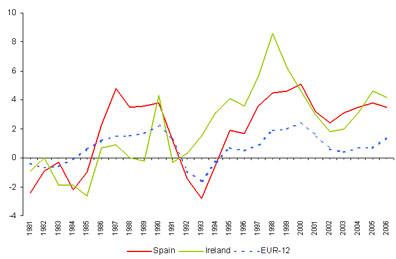|
The
boundaries between the so-called economic core and periphery
of
Europe
have shifted dramatically during the last two decades, as a
consequence of a catch-up by some member states, as well as
the most recent eastward enlargement of the European Union (EU).
Only two decades ago, the European
Economic Community was sharply divided between a rich core and
a poor periphery comprising all Southern European countries
and extending to Ireland.
In 1985, the unemployment rate reached record highs of 16.8%
in the Emerald Isle and 17.8% in Spain. The same year, Gross
Domestic Product (GDP) per head in Ireland stood at 68.9% of
the EU-15 average, whilst Spain’s
was at 71.9%. Accordingly, the two countries absorbed a large
share of European Community (EC) regional development funds as
they strived to converge with the rest of Europe. In spite of
the generosity of these funds, official statistics showed
little signs of convergence during the 1980s. Instead, there
seemed to be increasing divergence between a buoyant core and
a sluggish periphery that struggled to catch up. By those
years, many commentators and even policymakers had developed
the idea of a two-speed Europe as the only way to move forward
in the process of economic integration, and, more
specifically, in order to make the project of a European
Monetary Union viable.

Graph 1: Employment Growth. Annual %
change (Source: Eurostat) |
|

Graph 2: GDP Growth. Annual % change
(Source: Eurostat) |
This picture has changed dramatically during the past
fifteen years. The two laggards of Europe have experienced their most prolonged periods of
economic expansion in their recent economic history. This has
been particularly intense in the case of Ireland, as
demonstrated by certain economic indicators. In 2005, the
unemployment rate in Ireland had plummeted to around 4.4%,
while in Spain
it had also decreased to a record low of 7.8%, close to the
EU-15 average of 7%. Moreover, per capita GDP in Ireland now
stands at around 130% of the EU-15 average, right after
Luxembourg with the highest per capita income in Europe. In
the case of Spain, this figure has reached 91%, its highest
level in the post-World War II period. Graphs 1 and 2 show the
performance of these two countries compared to the average of
the EU-15 group, regarding the labour market and economic
growth. Within the context of what some scholars have
portrayed as a sluggish, rigid and sclerotic Europe, the
exceptional performance of the Irish economy led some authors
to compare it with the growth experiences of some Asian
countries, hence acquiring the epithet of ‘the Celtic Tiger’.
Even though the performance of the Spanish economy has not
reached the levels recorded in Ireland, it nonetheless remains
exceptional both in historical and comparative terms. As a
consequence of these changes, the new economic cleavages
within the EU are no longer characterised in terms of
north-south, but by a west-east division.
The question that arises immediately on examining this
data relates to what explains these experiences and whether
one can find any similarities between the two countries. For,
given the increase in income levels registered in both
countries, there are probably lessons to be learned from these
success stories by scholars and policymakers alike. An obvious
candidate to explain them would be the impact of the process
of European integration in triggering economic convergence
among member states. There are good grounds to support this
argument if one looks at the positive impact of European funds
aimed at creating physical and social capital in these two
countries, or the growth-enhancing effects of macroeconomic
stability brought about by their participation in the European
Monetary Union. However, European integration fails to explain
differences in the growth paths between countries. In this
article, however, I will explore the role of other three
variables whose impact has also been critical in initiating
and sustaining processes of economic development: these are
the role of migration and the transition from emigration to
immigration countries, inward flows of Foreign Direct
Investment (FDI) and national social dialogue. Difficult as it
is to provide magic recipes for growth and job creation, I
argue in this article that in addition to the beneficial
framework provided by EU policies, the three variables just
mentioned have been key ingredients contributing to boosting
employment growth, achieving above EU-average economic
performance and hence reversing the traditional laggard stance
of the two countries analysed here.
|



